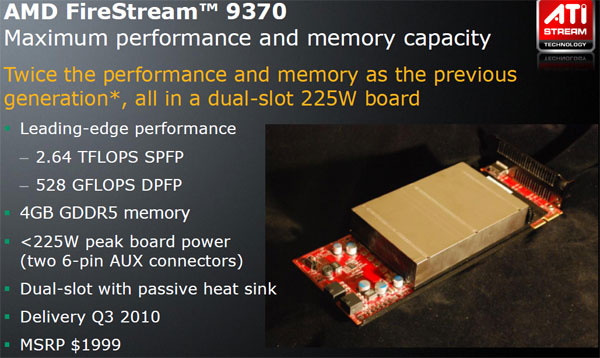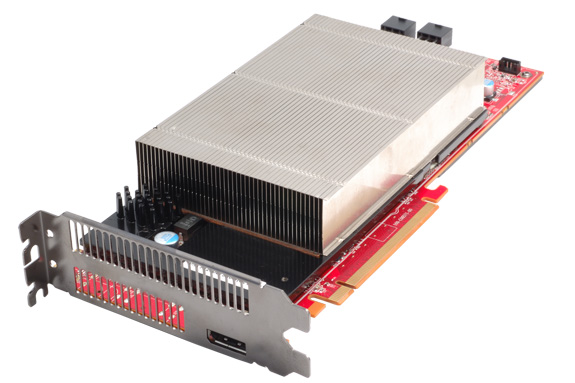The AMD FirePro W9000 & W8000 Review: Part 1
by Ryan Smith on August 14, 2012 4:00 AM ESTR.I.P: FireStream (2006 - 2012)
It goes without saying that with GCN AMD has significantly improved their GPU compute capabilities across the board. Consumer compute has already benefitted through the Radeon HD 7000 series, while professional graphics will begin benefiting with the FirePro W series, and GCN will be laying the foundation for the Heterogeneous System Architecture (HSA) in 2014. All of AMD’s product lines are benefiting from GCN… all of them but one: FireStream.
For those of you not familiar with FireStream, FireStream is (or rather was) AMD’s line of dedicated GPU compute products. Initially launched in 2006 and based on AMD’s R580 GPU, the FireStream was AMD’s first product geared exclusively towards GPU computing. Since 2006 AMD has regularly updated the product line, releasing new cards based on the RV670, RV770, and RV870 GPUs.
The most recent refresh of the product was the release of the FireStream 9300 series in 2010, which saw the FireStream family move to AMD’s first meaningfully capable OpenCL GPU, the RV870. Since then AMD ended up choosing to skip a 2011 refresh of the product based on their Cayman (VLIW4) GPU, which was a somewhat odd move at the time. While VLIW4 is not the kind of superior compute architecture that GCN is, it was still fundamentally designed to improve AMD’s compute performance, which it did thanks to the use of narrower SIMDs that allowed for a partial shift away from ILP to TLP. Nevertheless, as we found out after the fact with the launch of GCN, major users weren’t interested in moving to VLIW4, almost certainly having early knowledge that VLIW4 would be a dead-end architecture to be replaced by GCN in 2012.

In any case, with the release of GCN and its significant compute enhancements we have been expecting a major update to the FireStream product family. But as it turns out AMD has other plans.
Starting with the launch of the FirePro W series the FireStream family of products is being discontinued entirely. From here on the FirePro family will officially be pulling double-duty as both AMD’s professional graphics product and AMD’s compute product.
So why is AMD choosing now to discontinue the FireStream family at this point in time? Officially, AMD believes the FireStream family to be redundant. AMD’s FireStream cards were nearly identical to their FirePro cards in both build and performance, with the only practical difference being that FireStream cards had most of their display connectors removed. And AMD is right – by all accounts the FireStream 9300 series did very little to differentiate itself from the equivalent FirePro cards.
Meanwhile FireStream as a brand hasn’t kept up with NVIDIA’s Tesla business in the dedicated compute market. NVIDIA’s Tesla business is still a fledging business – it’s grown by leaps and bounds since 2010, but not as much as NVIDIA would like – but even so the company has created several distinctions between Tesla and Quadro that AMD never did replicate with FireStream. Chief among these was a compute-focused driver for Windows (NVIDIA calls it TCC), which stripped away all of the graphics capabilities of the card in order improve compute performance by freeing it from the control of the Windows display driver subsystem. Furthermore NVIDIA went and developed a couple different lines of Tesla cards, branching out into both traditional self-cooled cards for workstations and servers, and purely passive cards meant for specialized rackmount servers. For the FirePro V series AMD does have both active and passive cooled FirePro cards, however the FireStream cards were only available with passive cooling.

FirePro V9800P(assive)
The other limitation for AMD in this arena was of course their GPUs. GCN gives AMD a very potent compute architecture that is unquestionably competitive with Fermi and little Kepler, but there’s one thing NVIDIA will do that AMD won’t: build it big. AMD doesn’t strictly adhere to a small-die strategy (300-400mm2 is now their sweet spot), but they also don’t build 500mm2+ behemoths like NVIDIA. There’s a great deal more to compute performance than die size of course (especially when NVIDIA has disabled functional units on most Fermi Tesla parts for yield and power reasons), but it does lock AMD out of certain markets that desire as much individual GPU performance as possible. GPUs excel at parallel problems, however not every problem scales well across multiple GPUs (mostly due to memory sharing needs), which means there’s still a need for a very large GPU.
As a result of these factors, AMD’s RV870 FireStream cards never did gather a great following. GCN fixes the fundamental compute performance problem that was the chief factor holding back FireStream, but this would appear to be a case of too little, too late for FireStream. Of course AMD will continue to have a very important presence in the overall GPU computing market, but at least for now they’re seceding from producing a dedicated compute product.
In lieu of having a dedicated compute product FirePro will be serving both markets. In fact AMD tells us that there are already plans to build compute clusters out of FirePro W series cards (though they can’t name names at this time), reinforcing the notion that AMD is still active in the compute market even without a dedicated product. The big question of course is how potential customers will respond to this; customers may not be interested in a mixed-function part even if the performance was to be the same. Throwing a further wrench in AMD’s plans will be pricing – they may be underpricing NVIDIA’s best Quadro, but right now they’re going to be charging well more than NVIDIA’s best Tesla card. So there’s a real risk right now that FirePro for compute may be a complete non-starter once Tesla K20 arrives at the end of the year.
Perhaps for that very reason AMD’s promotional focus with FirePro is largely focused on professional graphics right now. Certainly the company is proud of their achievements in compute performance, but going by AMD’s marketing materials AMD is definitely focused on graphics first and foremost with FirePro.










35 Comments
View All Comments
damianrobertjones - Tuesday, August 14, 2012 - link
Over the years I've always popped over to this page to read the latest news and especially articles yet over the last year, or maybe a bit more, the articles haven't exactly been flowing. is the site slowing down?:(
bobsmith1492 - Tuesday, August 14, 2012 - link
This engineer doesn't like the so-called "professional" cards. I think they are a rip-off. My high-end workstation computer came with a top-of-the-line Quadro and it could barely handle a second monitor. I finally got a mid-level gaming card and was much happier with its performance.A5 - Tuesday, August 14, 2012 - link
Then the card you got was broken. Even integrated graphics can handle 2D on 2 displays no problem.bobsmith1492 - Wednesday, August 15, 2012 - link
That's what I would have thought, but no. Even scrolling down an Excel document was slow, pausing every second to redraw the whole screen. Same thing when dragging a window around over a background that was "stretch to fit." Garbage! Tried modifying graphics settings, hardware acceleration on/off, Googling like mad, posts in the AT forums but no-go.wiyosaya - Tuesday, August 14, 2012 - link
100 percent agree with your assessment that the pro cards are a rip off. The chips are the same chips as in gaming cards. The only difference is a few switches in firmware that cut off options when run in gaming cards.That firmware is also developed by the same developers; I say this after having worked in a similar field where the company I worked for marketed RIP software designed to print to copiers. All the features were in the software, but customers had to pay sometimes substantially extra to enable some of those features. In my opinion, anyone who thinks that there is a separate team developing "pro" drivers is mistaken.
With a PC that has enough processing power, IMHO, most professionals will not need the "extra capabilities" that the pro cards offer over gaming cards. Perhaps the only reason a pro would need a pro card, if you believe the marketing coming out of the pro card realm, is because you are working with a model that has thousands of parts.
However, there is a recent trend to kill double precision compute power in gaming cards. IMHO, this is going to hurt graphics card makers more than it will help. It was for this reason that I avoided buying a GTX 680 and opted for a 580 instead for a recent build of mine.
nathanddrews - Tuesday, August 14, 2012 - link
Apparently it doesn't hurt them at all since they're making a lot of money with pro cards. All you have to do is show this to a CAD designer and you'l make sale:http://vimeo.com/user647522
aguilpa1 - Wednesday, August 15, 2012 - link
All these videos illustrate is that certain hardware accelerated features are turned off at the bios and software level. It is an illustration of intentional vender modifications of a piece of hardware to differentiate the two in order to improve the profit of the other.This was clearly illustrated in early versions of Quadros whereby a simple bios update would re-enable the turned off features of the consumer model. These methods may have been disabled by now by the vendor as they get wise to the ways of gamers.
rarson - Tuesday, August 14, 2012 - link
Wrong. With a professional card, you pay for both the validation and the software, neither of which are professional quality in the consumer variants."That firmware is also developed by the same developers"
Firmware and drivers are two different things, by the way.
wiyosaya - Thursday, August 16, 2012 - link
"Wrong. With a professional card, you pay for both the validation and the software, neither of which are professional quality in the consumer variants."The marketing departments have done their jobs very well or you are "pro vendor shill," IMHO as that is what the vendor wants everyone to think. As I previously stated, having been in more than one position where the companies that I worked for sell "professional" software, it is not the case.
I expect that most pro software packages will run on most gamer cards with very little difference except, perhaps, when pushing the pro software package to its absolute limit. If anyone wants to pay $4K for a $400 card, they are certainly welcome to do that. IMHO, it is a complete waste of money.
PrinceGaz - Sunday, August 19, 2012 - link
If you really are a professional graphics (or compute) user and would rather take the chance by opting for a non-validated $400 card instead of a fully-validated and backed by the hardware and software-vendor $4,000 card, then you have got your priorities wrong. That or you're being seriously underpaid for the sort of work you are doing.Your software vendor isn't going to be very impressed when you report a problem and they find the system you are running it on has a GeForce or Radeon card instead of one of the validated professional cards and driver versions supported by it!